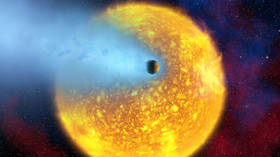Metal clouds found on hot Jupiter

An exoplanet has metal clouds and may experience rain made of liquid gems during the night that becomes airborne metals during the day. The study published on Monday in Nature Astronomy investigates the celestial object, which orbits a star about 885 light-years from Earth.
An international group of astronomers looked at the gas giant, called WASP-121b, as part of a study deciphering the atmospheric cycles between day and night. Until now, there had been very few observations of exoplanet atmospheres.
WASP-121b is an ultra-hot Jupiter-like planet, being larger in mass and diameter than the largest planet in our solar system. Like our Moon, WASP-121b is tidally locked, meaning that despite completing one orbit every 30.6 hours, one side of the planet, the dayside, always faces its star.
“Hot Jupiters are famous for having very bright day sides, but the night side is a different beast. WASP-121b's night side is about 10 times fainter than its day side,” study co-author Tansu Daylan, from the Massachusetts Institute of Technology, said in a statement.
In addition to its unusual metal clouds, the exoplanet has a glowing water vapor atmosphere and is being stretched into a rugby ball-type shape by the intense gravitational pull of the star it orbits.
The water cycle is considerably more chaotic than on Earth. Water particles are ripped apart on the day-side, before being forced onto the night-side by winds that reach more than 11,000 miles per hour (17,703 kilometers per hour).
“These winds are much faster than our jet stream and can probably move clouds across the entire planet in about 20 hours,” Daylan said.
The cold side is in fact cool enough to allow clouds of iron to form. Like the water vapor, these clouds are shoved around the planet. Before the clouds vaporize to gases on the hot side, it is believed that they may rain liquid gems on the cold side.
The researchers contend that their study provides a full and global understanding of exoplanet atmospheres. “With this observation, we're really getting a global view of an exoplanet's meteorology,” said lead study author Thomas Mikal-Evans from the Max Planck Institute for Astronomy in Germany.













